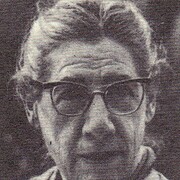Janet Lewis (1) (1899–1998)
Author of The Wife of Martin Guerre
For other authors named Janet Lewis, see the disambiguation page.
About the Author
Janet Lewis was a novelist, poet, and short-story writer whose literary career spanned almost the entire twentieth century. The New York Times has praised her novels as "some of the 20th century's most vividly imagined and finely wrought literature." Born and educated in Chicago, she lived in show more California for most of her adult life and taught at both Stanford University and the University of California at Berkeley. Among her other works are The Trial of Sren Qvist (1947), The Ghost of Monsieur Scarron (1959), Good-Bye, Son and Other Stories (1946), and Poems Old and New (1982). show less
Image credit: Sélection du Reader's Digest
Works by Janet Lewis
The earth-bound, 1924-1944 1 copy
Lewis, Janet Archive 1 copy
Poems, 1924-1944 1 copy
California poetry folios 1 copy
The Invention of the flute 1 copy
The Dear Past & Other Poems 1 copy
Associated Works
Literature: An Introduction to Fiction, Poetry, and Drama (1995) — Contributor, some editions — 925 copies
American Poetry: The Twentieth Century, Volume Two: E. E. Cummings to May Swenson (2000) — Contributor — 407 copies
Rediscoveries II: Important Writers Select Their Favorite Works of Neglected Fiction (1988) — Contributor — 30 copies
Tagged
Common Knowledge
- Legal name
- Lewis, Janet Loxley
- Birthdate
- 1899-08-17
- Date of death
- 1998-12-01
- Gender
- female
- Nationality
- USA
- Birthplace
- Chicago, Illinois, USA
- Place of death
- Los Altos, California, USA
- Places of residence
- Chicago, Illinois, USA
- Education
- University of Chicago
- Occupations
- poet
novelist
professor
librettist
historical novelist
short story writer - Relationships
- Winters, Yvor (husband)
- Organizations
- American Academy of Arts and Sciences
- Awards and honors
- Shelley Memorial Award (1947/1948)
Guggenheim Fellowship (1950 - 51)
Robert Kirsch Award (1985) - Short biography
- Janet Lewis was born in Chicago, Illinois. Her father taught college-level English and she credited him with being the first to teach her the rudiments of good prose and poetic style. Her first ambition was to be a poet. She graduated from the University of Chicago, where she was a member of the Poetry Club and a literary circle that included Glenway Wescott, Elizabeth Madox Roberts, and her future husband Yvor Winters. She taught at both Stanford University and the University of California at Berkeley.
Her first published collection of poems was The Indians in the Woods (1922), inspired by her childhood fascination with Native Americans. Further collections included The Wheel in Midsummer (1927), Janet and Deloss: Poems and Pictures (1990), and Poems Old and New, 1918–1978 (1981). Her debut novel, The Invasion: A Narrative of Events Concerning the Johnston Family of St. Mary’s, was published in 1932. She wrote several historical novels set in Europe, including The Wife of Martin Guerre (1941), The Trial of Soren Qvist (1947), and The Ghost of Monsieur Scarron (1959). She also wrote short fiction, collected in Good-bye, Son, and Other Stories (1946). She wrote six librettos for operas, and several song texts, some in collaboration with composer Alva Henderson.
She married Yvor Winters in 1926, and together they founded Gyroscope, a literary magazine that published from 1929 until 1931.
She was elected a Fellow of the American Academy of Arts and Sciences in 1992.
Members
Reviews
Lists
Schwob Nederland (2)
Awards
You May Also Like
Associated Authors
Statistics
- Works
- 23
- Also by
- 5
- Members
- 527
- Popularity
- #47,213
- Rating
- 3.9
- Reviews
- 11
- ISBNs
- 52
- Languages
- 4














